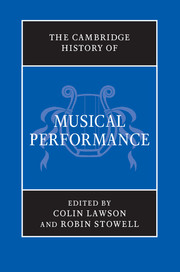Book contents
- Frontmatter
- PART I PERFORMANCE THROUGH HISTORY
- PART II PRE-RENAISSANCE PERFORMANCE
- PART III PERFORMANCE IN THE RENAISSANCE (C. 1430–1600)
- PART IV PERFORMANCE IN THE SEVENTEENTH CENTURY
- PART V PERFORMANCE IN THE ‘LONG EIGHTEENTH CENTURY’
- PART VI PERFORMANCE IN THE NINETEENTH CENTURY
- PART VII THE TWENTIETH CENTURY AND BEYOND
- 28 Musical performance in the twentieth century and beyond: an overview
- 29 Vocal performance in the twentieth century and beyond
- 30 Instrumental performance in the twentieth century and beyond
- 31 Case study: Karlheinz Stockhausen, Gruppen für drei Orchester
- PART VIII
- Index
30 - Instrumental performance in the twentieth century and beyond
from PART VII - THE TWENTIETH CENTURY AND BEYOND
Published online by Cambridge University Press: 28 March 2012
- Frontmatter
- PART I PERFORMANCE THROUGH HISTORY
- PART II PRE-RENAISSANCE PERFORMANCE
- PART III PERFORMANCE IN THE RENAISSANCE (C. 1430–1600)
- PART IV PERFORMANCE IN THE SEVENTEENTH CENTURY
- PART V PERFORMANCE IN THE ‘LONG EIGHTEENTH CENTURY’
- PART VI PERFORMANCE IN THE NINETEENTH CENTURY
- PART VII THE TWENTIETH CENTURY AND BEYOND
- 28 Musical performance in the twentieth century and beyond: an overview
- 29 Vocal performance in the twentieth century and beyond
- 30 Instrumental performance in the twentieth century and beyond
- 31 Case study: Karlheinz Stockhausen, Gruppen für drei Orchester
- PART VIII
- Index
Summary
Modernism has released its icy grip. During the latter decades of the twentieth century composers seemed able again to breathe Stefan George's ‘Luft von anderem Planeten’ (‘Air of another planet’), the opening soprano line of the last movement of Schoenberg's Second Quartet (1908), an iconic phrase emblematic of a newly extended or saturated chromaticism. These revolutionary beginnings of atonality (a negative term not favoured by Schoenberg) were hastened by the need to broaden the compositional palette, expressing and exploring a newly liberated emotional inner life. As Schoenberg memorably writes in his first letter to Kandinsky, ‘art belongs to the unconscious! One must express oneself! Express oneself directly! Not one's taste, or one's upbringing, or one's intelligence, knowledge or skill. Not all these acquired characteristics, but what is inborn, instinctive.’ Kandinsky's initial letter to Schoenberg, after hearing his music in 1911, which provoked the composer's enthusiastic response, in a sense clinches the movement towards expressionism: ‘In your works, you have realised what I, albeit in uncertain form, have so greatly longed for in music. The independent progress through their own destinies, the independent life of the individual voices in your compositions, is exactly what I am trying to find in my paintings.’ And so that particular strand of the complex story begins.
The neat but arbitrary use of 1900 as the starting point for many twentieth-century music histories no longer seems to obtain. Invoking Dahlhaus, the Romantic nineteenth century might be seen to end with the death of Wagner, and the twentieth to start with the earlymodern period in German and Austrian music: Mahler, Wolf, Zemlinsky, early Strauss and tonal Schoenberg straddling the two centuries up to the beginnings of atonality in 1908 and perhaps further to the end of the Great War. As Dahlhaus suggests, this periodmight even end as late as 1920 as the ‘revolution in musical technique around 1910 was succeeded by a profound transformation of aesthetic outlook around 1920’: here he is looking to Stravinsky and the twelve-tone Schoenberg. For the subject of this chapter, performance practice and instrumental exploitation, the twentieth century is not ‘long’ but, I would suggest, quite short, covering the mid-century from the 1950s to the late 1980s.
- Type
- Chapter
- Information
- The Cambridge History of Musical Performance , pp. 778 - 797Publisher: Cambridge University PressPrint publication year: 2012
- 2
- Cited by



